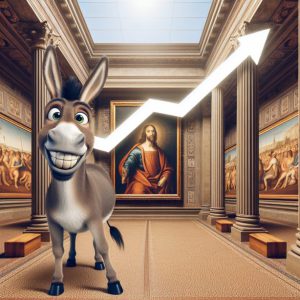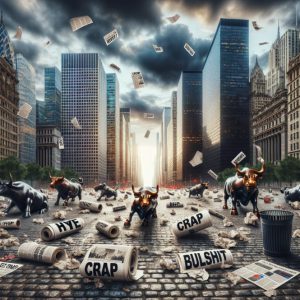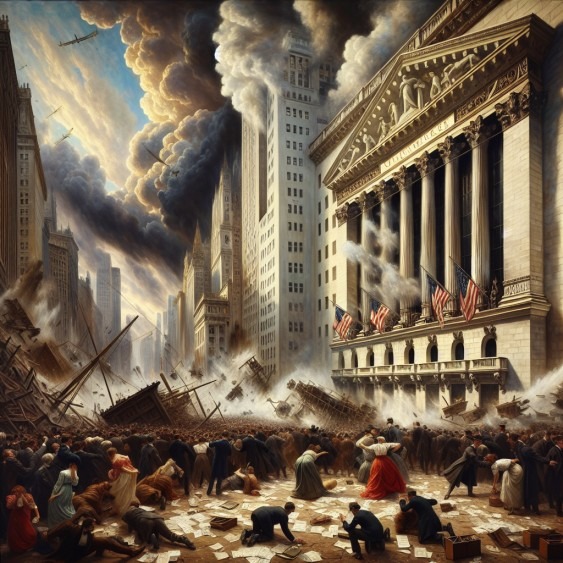Updated June 30, 2024
What is the stock market crash of 1929 often called? The Great Crash
An Introduction: The Infamous Fall
The Stock Market Crash of 1929, often referred to as Black Tuesday, was a pivotal moment in financial history. On October 29, 1929, investors traded approximately 16 million shares daily on the New York Stock Exchange, leading to a catastrophic market collapse. This event marked the beginning of the Great Depression, a decade-long economic slump that affected all industrialized countries. The crash preceded a speculative frenzy during the Roaring Twenties, a time of wealth and excess. The aftermath of Black Tuesday had far-reaching consequences, impacting nearly every segment of society and altering an entire generation’s perspective and relationship to the financial markets.
The Allure of the Stock Market
The irresistible allure of the stock market has resonated throughout history. Its charm lies in the promise of substantial monetary gain and the thrill and adrenaline rush that comes with risk. The stock market during the Roaring Twenties is a prime example of this allure. This era was marked by mass euphoria, with society swept up in a wave of unbridled optimism. The stock market emerged as a beacon of prosperity, its seductive promises of quick riches luring millions into its fold.
The stock market, often seen as a labyrinth of numbers and graphs, is more than just a trading platform. It’s a living organism that breathes and thrives on the hopes, fears, and ambitions of those who dare to engage with it. The Roaring Twenties exemplified this. The stock market was not just a place to trade stocks; it was a grand stage where dreams of wealth and prosperity danced in the minds of those who dared to dream.
However, this blind greed and widespread optimism found a chilling reflection in the Tulip Mania of the 17th century. This was a speculative bubble from the soaring prices of tulip bulbs in the Dutch market. The parallels between these two episodes are striking, highlighting how unchecked optimism can distort market values and fuel unsustainable economic phenomena.
Just as the skyrocketing prices of tulip bulbs created a speculative bubble, so did the unchecked optimism of the Roaring Twenties. The result was the same in both cases – an inevitable disaster. These historical episodes are a stark reminder of the volatile nature of the stock market and the dangers of unchecked optimism.
The allure of the stock market is undeniably intoxicating. Its promise of quick riches and the thrill of the chase can be overwhelmingly attractive. However, it’s crucial to remember that unchecked optimism can distort market realities, leading to unsustainable economic phenomena. As tulip bulbs and stocks rise, they can also fall, often with disastrous consequences.
The Tipping Point: The Crash
The euphoria riding high during the Roaring Twenties was not to last. The glittering facade of soaring stock prices bore little to no correlation to the actual earnings of the companies they represented. A dangerous chasm has formed a gap between perceived value and actual worth. It was as though society was dancing on a tightrope, a precipice of illusion and reality.
This glaring discrepancy was nothing less than a ticking time bomb, a silent threat growing more dangerous daily. The weight of this false perception became too heavy to bear, and it all came crashing down in October 1929, a month that has forever engraved itself into financial history.
The catastrophic crash was a financial disaster and a harsh wake-up call. It was a stark reminder of the dangers beneath the surface of an overheated market, a market distorted by the twin forces of speculation and greed. The crash was not random; it was the inevitable outcome of a market that had been allowed to run rampant with unchecked optimism and greed.
The events of October 1929 serve as a stark warning about the perils of speculation and greed. They highlight the consequences of allowing perceived value to diverge from actual value. The stock market crash was not a singular event but the culmination of a series of missteps and miscalculations. It was a domino effect, a cascade of failures that stemmed from a fundamental misunderstanding of market dynamics.
The Role of Mass Psychology and Speculation
With the lens of history, we can discern patterns and draw insights from the tumultuous events that marked the crash of 1929. A key player in this financial drama was the role of mass psychology and speculation. Leading figures in mass psychology and behavioural economics, such as Robert Shiller and Daniel Kahneman, argue that the crash was not a random event but the result of speculative bubbles heavily influenced by human psychology.
The irrational belief that the stock market would perpetually rise was a collective delusion that gripped society. This belief, fuelled by optimism and invincibility, prompted indiscriminate buying. Stocks were purchased not based on their actual value or the company’s financial health but on the expectation that prices would continue to rise. This indiscriminate buying catapulted stock prices far beyond their intrinsic value.
The fascinating interplay between human psychology and market dynamics is at the heart of this narrative. The way we perceive value, the decisions we make under the influence of fear or greed, and the collective behaviour of the market all weave together to create an intricate tapestry of economic activity.
Irrational exuberance, a term popularized by Robert Shiller, was a defining feature of the stock market during this period. It refers to the unfounded optimism that drives investors to push stock prices far beyond their intrinsic value. This irrational exuberance was crucial in creating the economic bubble that led to the crash.
Historical Parallels and Aftermath: Lessons from a Decade of Despair
The crash of 1929 bears striking similarities to other financial calamities like the South Sea Bubble of 1720 and the Panic of 1873. All were driven by speculative excess, mass hysteria, and the allure of quick riches, creating unsustainable bubbles destined to burst.
The 1929 crash ushered in the devastating Great Depression, marked by global economic stagnation, widespread poverty, and record unemployment. The human cost was immense, with images of jobless breadlines, evicted families, and shuttered businesses etched into history.
Governments were forced to reassess fiscal and monetary policies. New regulations and oversight bodies emerged to try to prevent future catastrophes. The crash and depression delivered hard lessons on the perils of unchecked speculation and regulatory failure – lessons still relevant today.
Lessons for the Future: Avoiding Another Crash
The 1929 crash is a cautionary tale of the dangers of unregulated speculation and euphoria. It shows how unchecked optimism, greed-fueled decisions, and a disconnect from reality can create a perfect storm, culminating in a devastating crash.
The crash highlights the critical importance of vigilant regulation and a realistic perspective on market valuations. Investors must be wary of the allure of quick riches and understand the actual value of investments.
A profound grasp of complex, interwoven market dynamics is essential. Economic indicators, sentiment, and global events influence markets in intricate ways. Navigating this landscape requires informed, prudent decision-making to avoid the pitfalls of 1929.
As we look forward, the lessons of 1929 are a vital guide. They underscore the importance of adequate guardrails against unchecked speculation and remind us of the immense human cost when financial disasters strike. Heeding these lessons is vital to building a more stable, sustainable, and equitable economic future.
Conclusion: Lessons from the Great Crash
The 1929 stock market crash was a cataclysmic event that echoes throughout economic history. As legendary investor Jesse Livermore noted, “There is nothing new in Wall Street. There can’t be because speculation is as old as the hills.” The crash underscores the dangers of unchecked speculation and the profound influence of human psychology on markets.
Plato’s words ring true: “The greatest penalty for failing to engage in politics is to be ruled by someone inferior to yourself.” The crash exposed the destructive potential of unregulated markets and unfettered greed. It led to sweeping changes in economic policies and the establishment of regulatory bodies worldwide.
The lessons of 1929 remain vital today. They emphasize the importance of vigilance, oversight, and a deep understanding of market dynamics. As economist John Kenneth Galbraith observed, “The function of economic forecasting is to make astrology look respectable.”
While the crash brought despair, it also demonstrated human resilience. Nations adapted and rebuilt in its wake. As we strive for a more stable financial future, the echoes of 1929 serve as a humbling reminder and guiding light. They underscore the power of learning from the past to build a more prosperous tomorrow.
Engaging Literary Journeys

The Dutch Tulip Bubble of 1637: A Tale of Madness and Ruin

Dividend Capture ETF: The Lazy Investor’s Dividend Strategy

What Was the Panic of 1907: A Triumph of Folly Over Reason

What Time is the Best Time to Invest in Stocks? When Fools Panic

The Volatility Paradox: Calm Markets but Soaring ‘Fear Gauge’ Trading

Which of the Following is a Characteristic of Dollar-Cost Averaging

Synthetic Long: Unlock Extreme Leverage Without the Risk
Best Ways to Beat Inflation: Resist the Crowd, Gain Insight

Gambler’s Fallacy Psychology: The Path to Losing

Dividend Harvesting: A Novel Way to Turbocharge Returns

Capital Market Experts: Loud Mouths, No Action

Modern Investing: Innovative Approaches in the Stock Market

Adaptive Markets Hypothesis: Master It to Win Big in Investing

Stock Market Crash Michael Burry: Hype, Crap, and Bullshit

Mainstream Media: Your Path to Misinformation and Misfortune

Market Dynamics Unveiled: Stock Market Is a Lagging Indicator

Mass Media Manipulates: Balancing Awareness & Trend Adoption
Will the Stock Market Crash: Analyzing Possibilities and Implications



